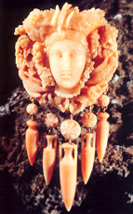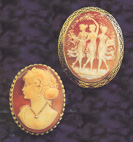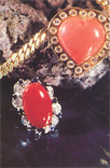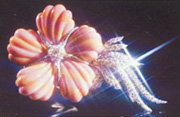|
|
|
HISTORICAL NOTES
Of mythological origin, born from the blood of the cut off head of Medusa, of which it would have kept the same power, the coral praises a very old history, where a bunch of legends glorifies its supposed therapeutic and propitiatory properties that are found in both the oriental and western civilization. For its apotropaic value, it will be paradoxically the Christianity to make the coral an integrate part of its symbology: paternoster's grains, crucifixes, monstrance, baptismal bars and ornaments for the Saint will become privileged objects in which the red sea-twig will take on a definitive consecration as symbol of Christ's Blood.
In Trapani (Italy), where the coral reefs were giving raw material in abundance, the art of workmanship of coral became methodic craft beginning from the XVth sec. when basically, in the "History of Trapani of 1591" it is spoken of the activity of "Corallini e Corallari Trapanesi", because this "good craftsmanship" it was already affirmed by half century as an expression of art, having already outdated the first phase of simple production, of grains and small spheres for the rosary crowns.
It's the severe school of the "bottega" that the apprentices will become gradually expert craftsmen, which after the discovery of the new coral reefs in Tabarca (Italy), around the 1530, will renew their enthusiasm with more competence and creative ability.
Unparalleled sacred and profane objects come out form caring and delicate hands: Virgin Mary statuettes, saints, crucifixes, dancers, jewel boxes, goblets, shrines, trays, lamps, caskets, jewels, frontals, stoups, monstrance, bolsters, frames, Nativity sets, in which the precious coral is mingled with gold, silver, copper, enamels, mother of pearls, lapislazuli, pearls, agates. They represent an endless series of masterpieces of fantasy and technical skill, in which the taste for the fantastic and grotesque, reminiscences of the Gothic culture present in the late local miniature, and in some aspects of the sculptural decoration of the "botteghe gaginesche" it renews and becomes actual and vibrant thanks also, to the indisputable influence of the already proved experience of the goldsmith from Palermo and Messina which manner contributed to refine and influence Trapani's craftsmen.
Already at the end of '500 and in the next two centuries, manufactures of exquisite make were created for high rank customers, because they were giving these presents to kings, princes, cardinals and popes. Memorable is the making of the "Coral Mountain", bought in the 1570 in Trapani, for a very high price, commissioned by Don Francesco Ferdinando Avalos de Aquino, Sicily's viceroy and sent to Philippe II of Spain, or the one donated in the 1631, by the Palermo's Senate to Pope Urban VIII. This appreciation of the aristocrat and ecclesiastic classes allowed to create a network of prestigious orders in the whole Europe, with the consequent demand of richer and more elaborated objects. So, it's not only a case if the majority of these masterpieces are outside Sicily in collections like the one of the Doria's, the Counts of Schoenborn a Pommersfelden, the Princes of Ligne, the King of Spain and, more recently of the Whitaker.
|
|
|
|
|
|
NATURAL NOTES
Coral, the "tree of seas" as it is often called, revered in ancient times as a magical stone united within it the three reigns: animal vegetal and mineral. For centuries, naturalists thought it was a marine plant that petrified when it was removed from water. It was only around 1700 thanks to the studies of Marseilles-based doctor Peysonnel that this red gem was in fact a marine animal. The numerous species and genders of coral are none other than a scaffolding, a type of ramified endoskeleton that is secreted by a marine colonial coelenterate that lives in warm and temperate waters. Its nature is the same for coral from every origin and colour - for Asian deposits, Polynesian ones, African, Mediterranean. Colours range from whites to reds to oranges, fiery red and dark colours right up to black. Among organic materials, corals were among the most sought after, following ivory, bone and amber. It was discovered in neolithic times as rough shaped branched clumps. In Catal Huyuk in Central Anatolia, examples of Mediterranean coral have been found that date back to about 6,000 years before Christ. Like amber, Coral followed thoughout the centuries well established trade routes through the Mediterranean. It was bought to the major coralworking centres in Naples, Sardinia, Malta and Sicily from the Red Sea, and across Asia to Tibet and Mongolia from the Indian Ocean. Until the second iron age, other trade routes took coral as far as the Celtic countries and Brittany. The traditional gathering grounds, however, remain the reefs in the Mediterranean, in Spanish and North African waters, as well as off thecoast of Malta. In Italy, coral is gathered in the Ligurian Sea, around the coast of Sicily and off the shores of the neighbouring islands. In Sicily, the coral is gathered between Sciacca, from where comes the famous orange coral called Fossil Coral, Linosa and Pantelleria. The shores around the Red Sea are replete with the local variety - a pink tubular species, which has been conserved in the predynastic tombs of Abido in predynastic Egypt. Coral-based jewels dating back to the times of Ptolemy have also been found. Coral was also incorporated in Celtic, Central European and Siberian ornaments of the sixth century before Christ. But its use in Rome and Greece, contrary to what one is given to believe, was not widespread. There are few examples of sculpted products like cameos and other cut elements. A few archaic Greek gems were found in Perachora and date back to the sixth century before Christ, while a few sculpted pieces mounted in golden and bronze rings from the first to the third century AD remain. Imitation antique coral jewellery uses materials, from common plastic to glass, dyed shells and coral powder that has been heat pressed and treated with resins. The organic nature of coral makes it mostly impervious to attack from outside agents and for that reason it remains little changed with time. However, any object made of coral will after, centuries dehydrate and change colour, although some examples of perfectly conserved corals exist. Abnormal coloration is mainly due to the possible presence of salts that can colour it, entering the porous structure of the coral from the seabed. A thin flaky film can also form at the surface, caused by chemical alteration of the calcium carbonate into oxide and hydroxide. In ancient strata are also present acid alkaline solutions that can cause a selective corrosion which endow the coral with a pattern of thin undulating microbands. The miracles of nature never cease to amaze us. Coral plays a vital role in helping to maintain the sea's delicate ecological balance during its life. Under the surface of the seas, thousands of little white polyps, similar to flowers with subtle petals live in colonies that are linked by a system of gastro-vascular canals. Day after day they grow, slowly and continually secreting the calciferous structure of the colonies that make up the large barrier reefs. Coral reproduces by budding (asexual reproduction), but also by sexual reproduction, which ends in the generation of individuale that are capable of finding fresch colonies. There are 27 species of coral of which only about five are adapted to use in the jewellery industry. Coral reefs are classified according to their size and appearance. When the reef is inverted with a bollow bottom or book shaped, it is called "prementina". A reef is classified as "chiaia", "chianozza" or "chianone" if the plane of expansion of the column is horizontal. When the branches on one side of the reef grow upwards, it is called a "pettatta", while "mazzarello" or "maciottolo" coral tends to cover the whole of a large clump of rocks. In the Mediterranean, coral can be found at dephts of 25- 200 metres, but lives at 400 metres under the surface of the sea in the case ofasian deposits. Recently, two new varieties of coral Garnet and Deep Sea, which are still not classified as species, have been found in the Pacific Ocean close to the islands of Midway and Hawaii. Deep Sea can grow at depths of 800-2,000 metres, rendering its precise morphological study difficult and as well as its exploitation. The differences between Mediterranean coral and its Asiatic counterpart are clear-cut. The Mediterranean variety is bushshaped and its colouring is a more florid or vivacious one. It is generally gathered when the colony is in full expansion. The Orient, on the other hand, offers a fanshapped coral that grows among one plane only and is harvested when growth of the colonies is near its end. For this reason, Asian coral are often referred to as decayed or dead while the colours are far more varied and often presents white vein-like stains. Both varieties are equally attractive and can be for all types of fashioning. However Mediterranean coral especially the Italian variety is rarer and more in demand, not least in Torre del Greco, the capital of coralworking. |
|



